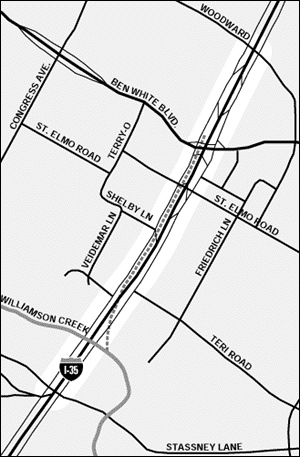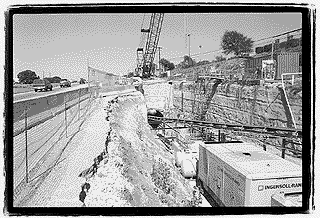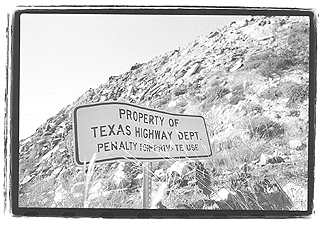Tunnel Vision
TxDOT Sees No Evil in Williamson Creek Tunnel
By Nate Blakeslee, Fri., Oct. 3, 1997
|
|
Flooding has been such a problem on the creek that the city was forced to purchase 23 houses two years ago as part of a long-term flood control plan, which has yet to be completed. "If we get another bad flood, we've been told by the city that we won't be allowed to rebuild if the damage is too great," Aquino says. "They'd just buy out the mortgage and we'd have to pick up and leave our home."
But it's more than just the flooding that concerns residents, Aquino adds. There's the fact that the tunnel will collect untreated storm runoff from the highway interchange, carry it about a mile underground, and dump it into Williamson Creek upstream from McKinney Falls, a popular swimming hole. The resulting pollution will be devastating to the Falls, Aquino says. "Everybody's worked so hard to clean [the Falls] up," Aquino says. "I don't want to see all that work be for nothing."
What's especially galling to critics of the tunnel project is that the tunnel was not included in TxDOT's initial design, nor in the environmental impact study. Further, it is the position of TxDOT Planning Director Robert Stuard, as quoted in the January 20 Austin American-Statesman, that TxDOT is not required to treat highway storm water runoff, except in areas designated as environmentally sensitive. (Stuard did not return calls placed by the Chronicle over a 10-day period.) And, in what has now become a fairly notorious decision, TxDOT determined that in any case, the addition of the tunnel did not constitute a "significant change" in the project, and therefore required no additional environmental impact study or public hearings.
Not Our Problem
At the urging of the Southeast Corner Alliance of Neighborhoods (SCAN), the Austin Transportation Study (ATS) formed the Water Quality Task Force to study the tunnel issue last March. Under the direction of Travis County Commissioner Margaret Gomez, Austin State Representative Glen Maxey, citizen members D.W. Brown and Bruno Conigliano, and City Councilmembers Jackie Goodman and Beverly Griffith, the task force conducted meetings with citizen groups and city and state staff, hired a consulting firm, and eventually came up with a proposal for a mitigation program to protect the creek and McKinney Falls State Park, which it presented at the August 18 meeting of the ATS. Although the tunnel would still be built (it's actually about half-dug already), under a program suggested by the Water Quality Task Force, contractors would install filtration ponds, oil and grit separators, energy dissipaters, and other relatively low-tech mechanisms for reducing the potential for pollution, erosion, and flooding in Williamson Creek. The task force proposed that the $1.2 million program be jointly funded by the city and the state, and even secured unanimous council approval for the city's half of the bill at the Sept. 5 city council meeting.
Following the task force's lead, the council requested that TxDOT participate as an equal partner in funding the project. To put the city's fairly modest request in perspective, TxDOT was essentially asked to increase its budget for the $15 million tunnel by about 4%. The response from TxDOT? "They basically said that while they had no objection to the city's proposal," recalls task force member Brown, "they also had no intention of paying for it."
A July 25 letter from TxDOT to the ATS put it bluntly: "We look to others to provide and fund" the mitigation efforts, since "the items proposed are above and beyond what is required from TxDOT for this and future projects on the IH 35/US 290 interchange."
What's a Little Runoff?
If TxDOT sounded somewhat cavalier in its dismissal of six months of labor by the Water Quality Task Force, that's because the agency has decided that the tunnel will have no significant effect on the creek, and it's simply not TxDOT's responsibility. But, according to the task force, TxDOT may be wrong on both accounts. Although the Federal Highway Administration (FHA) has concurred with TxDOT's conclusion that the tunnel constitutes "no significant change" in the project, the ATS task force, with the unanimous approval of the entire ATS body, has appealed that decision in a letter to the President's Council on Environmental Quality. Meanwhile, the task force has also set up a meeting between the city drainage utility and the FHA Regional Director to discuss the tunnel. The ATS has "requested" that TxDOT also attend, sounding a bit like an intimidated school teacher dealing with a recalcitrant student, one who just might be a little too big to send to the principal's office.
 |  Williamson Creek TunnelThe highlighted section of I-35 (left) is to be widened. The dotted line represents the Williamson Creek Tunnel, which will direct stormwater run-off from the expansion into the creek and on to McKinney Falls (above). |
As currently designed, the tunnel contains no pollution controls whatsoever. Compared to the existing runoff reaching the creek, R.J. Brandes estimates that the tunnel outflow will have over twice the amount of lead, about a third more nitrogen (meaning more algae growth and less fish), and about a third more suspended solids, which means murky water in the creek and at McKinney Falls. But there's no need to speculate about the tunnel's effects, says Donald Dodson of the Dawson Neighborhood Association. Simply look at what the previous drainage tunnel built for Ben White improvements did to East Bouldin Creek, about a mile west of the current construction. On September 19, Dodson and other residents of the neighborhood gave several members of the ATS a tour of the creek below the two year-old tunnel's outflow.
Immediately below the tunnel is a pool of greasy water and floating garbage, retained by a low wall designed to slow the velocity of the outflow following storms. The wall was added, after the fact, in response to neighbors' complaints about increased erosion, which continues to threaten backyards and houses abutting the creek bed. Several large trees have succumbed to the heightened flow from the tunnel, including a recently fallen pecan that was at least 100 years old.
Residents along Williamson Creek below the new tunnel's future outflow also fear increased erosion, noting that the city's study predicts both higher volume and increased speed.
The EPA Cometh
As for TxDOT's arguments that pollution in Williamson Creek is not its concern, a fact that does not seem to have entered the public record is that a new Environmental Protection Agency regulation is in the pipeline that may change the way storm water runoff is handled in Austin. The proposed regulation, which has a compliance date of September 1, 1998, will require TxDOT to do exactly what the neighborhoods, the city, and the Water Quality Task Force are asking for with respect to the Williamson Creek tunnel: reduce the impact of storm water runoff. The proposed regulation stems from an EPA review of TxDOT's existing storm water management program, the creation of which was a requirement of 1992 regulations implementing revisions to the Clean Water Act. According to EPA environmental engineer Claudia Hosch, the EPA found TxDOT's program deficient in the area of (surprise, surprise) "determining requirements for structural and non-structural post-construction storm water quality controls on new and significant reconstruction of roads and highways."
|
|
Nowhere in the proposed regulation does it limit TxDOT's responsibility to just protecting the Edwards Aquifer. It does, however, specify that special attention be paid to projects that may impact "sensitive or unique areas." That would certainly include McKinney Falls, which the city has spent millions of dollars cleaning up over the past 10 years.
Because the proposed regulations have received so much public interest, mainly from concerned Southeast Austin neighborhoods, the EPA has gone to the unusual step of calling a public hearing, scheduled for October 7 (see box), before finalizing the language of the new rules. One of the questions residents along Williamson Creek will likely ask the EPA at the hearing is this: How long has TxDOT known that this proposed regulation was in the works? Did the agency know about it, for example, when it claimed that the suggested mitigation of the Williamson Creek tunnel goes "above and beyond what is required from TxDOT for this and future projects"?
Mike Walker, TxDOT's district environmental
coordinator, conceded that the agency was aware that the new regulation was on the way. "We knew it was coming," he said, "but we didn't know what would be in it."
That response doesn't hold water, says Water Quality Task Force member Brown, a South Austin resident who lives near the creek. "The EPA began putting rules about highway storm water runoff in place at least five years ago," he says, "before the design of the tunnel was even conceived."
Federal environmental regulations are deliberately written in very general language, Brown explains, so that individual entities, like the City of Austin or TxDOT, can tailor their various compliance programs for optimum efficiency. In practice, however, this means there's often a wide range of enforcement. "Some entities," says Brown, "interpret the rules in a very progressive and positive fashion and use the flexibility of the program to do the right thing." He cites as an example the highway department of the State of Washington, which has interpreted EPA rules to mean that it must take responsibility for treating all highway runoff. Period. On the other hand, Brown notes, "Others, like TxDOT, take advantage of the general language to do absolutely nothing."
Power Grab
Because of its funding structure, which consists primarily of state and federal gas tax revenues dedicated explicitly to transportation funding, TxDOT is a uniquely independent bureaucracy. One of the few entities to which it is accountable, to a limited degree, is the Metropolitan Planning Organization (MPO) for a given district, which for the Austin area means the Austin Transportation Study. The ATS has its limitations, as the battle over the Williamson Creek tunnel has amply demonstrated, but it does provide a small measure of accountability. But even that was recently threatened. About a month before the Water Quality Task Force gave its report to the full ATS, TxDOT submitted proposed rule changes for MPOs in Texas.
In general, the proposed rule changes would have limited the scope of the ATS's authority, removing its ability, among other things, to fund project level planning, such as the work performed by the Water Quality Task Force. ATS director Mike Aulick identified the measures as an effort by TxDOT staff to consolidate its power, particularly in Central Texas, one of the few areas in the state where the local planning authority takes its job seriously. Resistance from the two state senators on the ATS committee, Gonzalo Barrientos and Jeff Wentworth, will likely spell the end to this particular effort to circumvent the excess of democracy in our part of the state. But even with Barrientos at the helm, TxDOT is still, as the senator noted at the Sept. 8 ATS meeting, "the 900 pound gorilla" when it comes to questions of jurisdiction and authority.
As a suggestion for a solution of sorts, Richard Hamner, Barrientos's aide, has encouraged the city's drainage utility to apply for leftover federal funds controlled by the ATS to pay for half of the $1.8 million program to mitigate the tunnel's impact. But the competition for that money will be stiff, and, in any case, many believe that TxDOT is shirking its share of the responsibility. After all, critics reason, the city has already gone above and beyond its financial duty by offering to put up half of the money.
If the proposed mitigation facilities are to be incorporated into the tunnel, they would have to be done soon. In a last ditch intervention effort, the Water Quality Task Force submitted a written plea to Texas Transportation Commissioner David Laney, imploring him to consider the findings of the R.J. Brandes study and the city council's request to participate in the mitigation program, before continued construction closes the "window of opportunity" for including the proposed facilities. The letter alludes to the possibility that TxDOT might have to go back and retrofit the tunnel anyway, at greater cost, under the proposed new EPA regulations.
How likely is retrofitting? Walker at TxDOT wouldn't comment on that question, noting only (with a rather anxious tone) that "there's a lot of untreated runoff from highways in Austin." Although the proposed EPA regulation does not specifically require retrofitting, according to Water Quality Task Force member Brown, TxDOT probably will have to do it "somewhere down the road." And if anything is to be retrofitted after the proposed regulation is adopted, says Brown, the Williamson Creek tunnel will almost surely be at the top of the list.
So why wait? As Jackie Goodman forcefully observed at the August 18 ATS meeting, the city and the neighborhoods have worked for years to get the pollution in McKinney Falls down to suitable levels for swimming. And while it will never be Barton Springs, the results have paid off, and Williamson Creek is full of swimmers again. "I think we've earned the right," she said, her voice rising about as loud as it ever gets, "to ask the state to take care of some of its own pollution." Her reward? A burst of applause from neighborhood representatives and a bored stare from the TxDOT representative in attendance.
Got something to say on the subject? Send a letter to the editor.








